Hold down the T key for 3 seconds to activate the audio accessibility mode, at which point you can click the K key to pause and resume audio. Useful for the Check Your Understanding and See Answers.
Lesson 2: Relating Stoichiometric Quantities
Part b: Mole-to-Mass Relationships
Part a: Mole-to-Mole Relationships
Part b: Mole-to-Mass Relationships
Part c: Mass-to-Mass Relationships
Part d: Percent Yield
Part e: Stoichiometry Plus
The Big Idea
Learn how to solve two-step stoichiometry problems by combining mole-to-mole conversions with molar mass calculations, empowering you to determine the mass of products or reactants in chemical reactions.
Before you begin, do you need to review simple mole-to-mole conversions? See Lesson 2a.
What is a Two-Step Stoichiometry Problem?
Lesson 2 of this Stoichiometry Chapter of our Chemistry Tutorial is loaded with a collection of stoichiometry problems – advice, direction, examples, more examples, and opportunities to practice. These problems provide a balanced chemical equation and an amount of a reactant or product. The unknown quantity to solve for is how much reactant or product would react or be formed. Our solutions demonstrate how to use the factor label method (conversion factors) with an understanding of mole ratios and molar mass to solve for the unknown.
The problems on this page are two-step problems. One step will involve a mole ratio to convert between moles of reactant and moles of product. The other step will involve a molar mass to convert between the mass and the moles of either a reactant or a product. You will need to use a periodic table to calculate a molar mass. (If need be, review: How to Calculate the Molar Mass.)
Here are two typical problems that fit this category of two-step problems:
Mole-to-Mole-to-Grams Problem
Given: N2(g) + 3 H2(g) → 2 NH3(g)
Determine the mass (in grams) of NH3 produced from the reaction of 1.98 moles of N2.
Grams-to-Mole-to-Mole Problem
Given: N2(g) + 3 H2(g) → 2 NH3(g)
Determine the moles of NH3 produced from the reaction of 17.5 grams of N2.
We have highlighted in red the given quantity and the desired quantity for both problems. Note that in each problem the amount of a reactant is given and the amount of a product is desired. Also note that the given amount and the desired amount have different units.
Planning a Solution Pathway for a Two-Step Stoichiometry Problem
 Success in a Stoichiometry unit requires an understanding of relationships. Lesson 1 was devoted to understanding relationships. Coefficients in the balanced chemical equation provide the information required to convert from moles of one substance to the moles of another substance. Molar mass values provide the information required to convert from the mass of one substance to the moles of the same substance (or vice versa). When put together, molar mass and coefficients allow a student to convert from grams of substance 1 to moles of substance 2 OR from moles of substance 1 to grams of substance 2.
Success in a Stoichiometry unit requires an understanding of relationships. Lesson 1 was devoted to understanding relationships. Coefficients in the balanced chemical equation provide the information required to convert from moles of one substance to the moles of another substance. Molar mass values provide the information required to convert from the mass of one substance to the moles of the same substance (or vice versa). When put together, molar mass and coefficients allow a student to convert from grams of substance 1 to moles of substance 2 OR from moles of substance 1 to grams of substance 2.

Using Mole Island to Plan a Solution Pathway
We introduced Mole Island in Lesson 1c. Mole Island is a graphic organizer that helps a student develop a plan for navigating their way through a problem. Mole Island shows what is related to what and how it is related. The graphic below is a version of Mole Island that has been customized for the ammonia synthesis reaction. The mass (in grams) and the moles of each reactant and product are identified on the diagram. Arrows connect these quantities. Each arrow represents a conversion step. One conversion factor is required per arrow. The words next to the arrows (Molar Mass, Coefficients) indicate the information that will be used in the conversion factor.
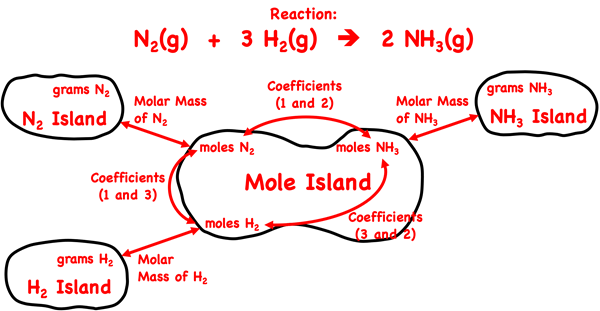
A mole-to-mole conversion (occurring between quantities on Mole Island) requires the use of coefficients. A mole-to-gram conversion for a specific substance requires the use of a molar mass. On this page, the two conversions will be combined.
We always recommend an understanding of these relationships before you begin a problem. Use Mole Island or a similar tool to develop a plan for converting from the given quantity to the desired quantity. Most student frustration in a Stoichiometry unit can be traced to the (ill-advised) tendency to start attempting to calculate an answer without a plan and without a set of conversion factors that express that plan.
Example 1: Mole-to-Mole-to-Gram Conversions
Let’s develop a plan and solve the first problem:
Given: N2(g) + 3 H2(g) → 2 NH3(g)
Determine the mass (in grams) of NH3 produced from the reaction of 1.98 moles of N2.
Our plan for this problem will begin with the Mole Island diagram (below). We identify the given quantity – moles of N
2. And we identify the desired quantity – grams of NH
3. We mark both of these on the diagram. There are two arrows between the given quantity and the desired quantity. The first arrow has the words
Coefficients listed above it. We will use the coefficients from the balanced chemical equation to convert from moles of N
2 to moles of NH
3. This will be our first conversion factor. The second arrow has the words
Molar Mass of NH3 listed above it. We will calculate the molar mass of NH
3 and then use it in a conversion factor to convert from moles of NH
3 to grams of NH
3. This will be the second conversion factor.
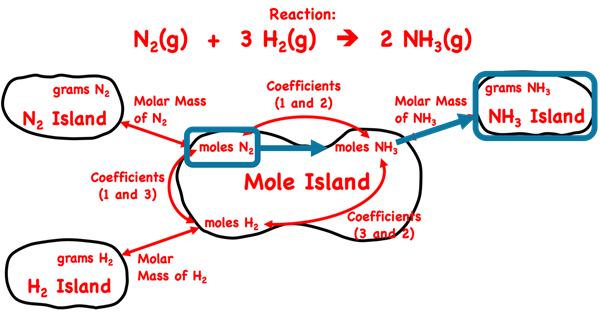
We know we will need the NH3 molar mass, so we will calculate it first before we begin setting up the conversion factors. Using the periodic table and rounding the result to the second decimal place, the value is 17.03 g/mol. We can think of this as 17.03 grams/1 mole of NH3.

Now we will set up our conversion factors (units only, no numbers) in accordance with the plan outlined above. This is shown below. Note how a denominator unit will cancel a numerator unit or a unit on a given quantity. The one uncancelled unit is the unit on the answer.

Now that the units of the conversion factors have been set up, we will insert numbers into the numerators and denominators. The first conversion factor includes coefficients from the balanced chemical equation. Based on the chemical equation, the 1 coefficient goes with mol N2 and the 2 coefficient goes with mol NH3. The second conversion factor includes the molar mass. As it will always be with a molar mass conversion factor, the 1 goes with the mole and the 17.03 goes with grams.

The final task involves a calculation of the answer. As it is always done, start with the numerical value of the given quantity (1.98) and multiply by all the numbers of the numerators (x2 and x17.03) and divide by all the numbers in the denominators (÷1 and ÷1). The resulting answer is rounded to the proper number of significant digits.
The PUNC Order of Problem-Solving
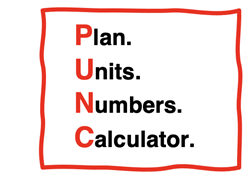 There is something important about our solution that you should not overlook. Observe the order in which the solution proceeded. Once the planning was complete, we set up conversions factors with units (no numbers). Then we inserted the numbers; the units informed us of where to put the numbers. Finally, we reached for our calculator to calculate the answer. The order is: plan, units, numbers, calculator.
There is something important about our solution that you should not overlook. Observe the order in which the solution proceeded. Once the planning was complete, we set up conversions factors with units (no numbers). Then we inserted the numbers; the units informed us of where to put the numbers. Finally, we reached for our calculator to calculate the answer. The order is: plan, units, numbers, calculator.
Example 2: Gram-to-Mole-to-Mole Conversions
Now let’s consider the second problem:
Given: N2(g) + 3 H2(g) → 2 NH3(g)
Determine the moles of NH3 produced from the reaction of 17.5 grams of N2.
We will start the planning with the Mole Island graphic (below). We identify the given quantity – grams of N
2. And we identify the desired quantity – moles of NH
3. We mark both of these on the graphic. There are two arrows between the given quantity and the desired quantity. The first arrow has the words
Molar Mass of N2 listed above it. We will calculate the molar mass of N
2 and then use it in a conversion factor to convert from grams of N
2 to moles of N
2. This is the first conversion factor. It gets us from the starting point on N
2 Island onto Mole Island. The second arrow goes from moles of N
2 to moles of NH
3. This arrow has the words
Coefficients listed above it. We will use the coefficients from the balanced chemical equation to convert from moles of N
2 to moles of NH
3. This will be our second conversion factor.
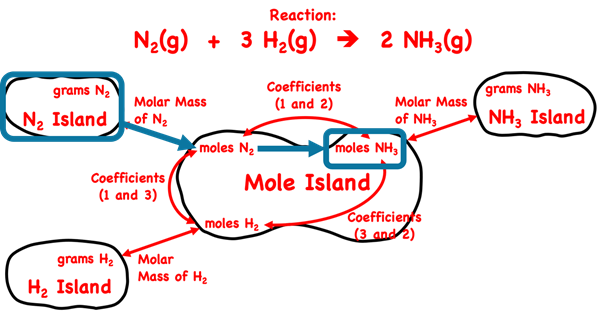
Before we set up our conversion factors, we will calculate the molar mass of N2 since it is needed in the first conversion factor. Using the periodic table and rounding the result to the second decimal place, the value is 28.01 g/mol. Think of this as 28.01 grams/1 mole of N2.
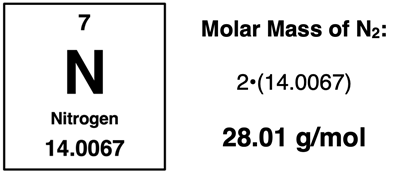
Now we will set up our conversion factors (units only, no numbers) in accordance with the plan outlined above. This is shown below. Note how a denominator unit will cancel a numerator unit or a unit on a given quantity. The one uncancelled unit is the unit on the answer.

Once the units of the conversion factors are set up, insert numbers into the numerators and denominators. The units inform you as to where to put the numbers. The first conversion factor includes a molar mass value. It will always be the case with a molar mass conversion factor that the 1 will be with the moles and the molar mass value (28.01) will be with the grams. The second conversion factor includes the coefficients from the balanced chemical equation. Based on the chemical equation, the 1 coefficient goes with mol N2 and the 2 coefficient goes with mol NH3.

The final task involves a calculation of the answer. As you will always do, start with the numerical value of the given quantity (17.5) and multiply by all the numbers of the numerators (x1 and x2) and divide by all the numbers in the denominators (÷28.01 and ÷1). The resulting answer can be rounded to the proper number of significant digits.
We have included two more examples below. Follow the logic and process. Then take time to try it yourself. This is important! You have to be more than a spectator to have success with stoichiometry. Use one or more of the suggestions in the Before You Leave section.
Example 3: Mole-to-Mole-to-Grams Conversions
Given: 3 Ti(s) + 2 N2(g) → Ti3N4(s)
Determine the moles of Ti3N4 produced from the reaction of 284 g of Ti.
Mole Island (shown below) has been customized for this particular reaction. We will use it to develop a plan. We identify the given quantity – grams of Ti. And we identify the desired quantity – moles of Ti
3N
4. We mark them both on the graphic and notice two arrows between the given quantity and the desired quantity. The first arrow has the words
Molar Mass of Ti listed above it. We will use the molar mass of titanium in a conversion factor to convert from grams of Ti to moles of Ti. This is the first conversion factor. It gets us from the starting point on Ti Island onto Mole Island. The second arrow goes from moles of Ti to moles of Ti
3N
4. This arrow has the words
Coefficients listed above it. We will use the coefficients in the balanced chemical equation to convert from moles of Ti to moles of Ti
3N
4. This will be our second conversion factor.
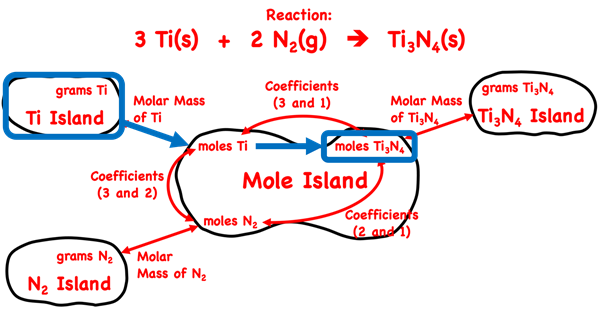
Now we will set up our conversion factors (units only, no numbers) in accordance with the plan outlined above. This is shown below. The denominator unit of the first conversion factor cancels the unit on the given quantity. The denominator unit of the second conversion factor cancels the numerator unit on the first conversion factor. The one uncancelled unit is the unit on the answer.

Now insert numbers into the numerators and denominators. The first conversion factor includes the molar mass value for Ti; we find it on the periodic table – 47.87 g Ti per 1 mol Ti. The 1 is inserted in front of the mol Ti and the 47.87 is inserted in front of the g Ti. The second conversion factor includes the coefficients from the balanced chemical equation. Based on the chemical equation, the 3 coefficient goes with mol Ti and the 1 coefficient goes with mol Ti3N4.

The final task involves a calculation of the answer. As always, start with the numerical value of the given quantity (284) and multiply by all the numbers of the numerators (x1 and x1) and divide by all the numbers in the denominators (÷47.87 and ÷3). The resulting answer can be rounded to the proper number of significant digits.
Example 4: Mole-to-Mole-to-Grams Conversions
Given: 3 Ti(s) + 2 N2(g) → Ti3N4(s)
Determine the mass (in grams) of N2 that will react with 4.28 moles of Ti.
Once more, we start the problem by developing a plan using the Mole Island graphic (below). We identify the given quantity – moles of Ti; and we identify the desired quantity – grams of N
2. We mark both of these on the graphic. There are two arrows between the given quantity and the desired quantity. The first arrow has the words
Coefficients listed beside it. We will use the coefficients from the balanced chemical equation to convert from moles of Ti to moles of N
2. This will be our first conversion factor. The second arrow has the words
Molar Mass of N2 listed below it. We will use the molar mass of N
2 (calculated earlier on this page as 28.01 g/1 mol) to convert from moles of N
2 to grams of N
2. This will be the second conversion factor.

Now we set up our conversion factors (units only, no numbers) in accordance with the plan outlined above. This is shown below. Note how a denominator unit will cancel a numerator unit or a unit on a given quantity. The one uncancelled unit is the unit on the answer.

Numbers are now inserted into the numerators and denominators. The first conversion factor includes coefficients from the balanced chemical equation. Based on the chemical equation, the 2 coefficient goes with mol N2 and the 3 coefficient goes with mol Ti. The second conversion factor includes the molar mass. As it will always be with a molar mass conversion factor, the 1 goes with the mole and the 28.01 goes with grams.

The final task involves a calculation of the answer. As you will always do, start with the numerical value of the given quantity (4.28) and multiply by all the numbers of the numerators (x2 and x28.01) and divide by all the numbers in the denominators (÷3 and ÷1). The resulting answer can be rounded to the proper number of significant digits.
Next up: Learn to tackle full mass-to-mass problems in Lesson 2c.
Before You Leave - Practice and Reinforcement
Now that you've done the reading, take some time to strengthen your understanding and to put the ideas into practice. Here's some suggestions.
- Having troubles with using Conversion Factors. Study our Factor Label Method page. It discusses the method of using conversion factors to cancel units and solve for an unknown.
- Practice is incredibly important. The Calculator Pad includes a collection of problems that cover a myriad of Chemistry concepts. Students can check their answers, receive feedback, and have opportunities to correct their answers. It’s a great place to practice. Try Problem Set ST3 and Problem Set ST4 for great practice on mole-to-mass stoichiometry.
- The Check Your Understanding section below includes questions with answers and explanations. It provides a great chance to self-assess your understanding.
- Download our Study Card on Mole-to-Mass Conversions. Save it to a safe location and use it as a review tool.
Check Your Understanding of Two-Step Stoichiometry Problems
Use the following questions to assess your skill at solving two-step stoichiometry problems. Tap the Check Answer buttons when ready.
1. Given: 3 Ti(s) + 2 N2(g) → Ti3N4(s)
The following sets of conversion factors are being used to convert from the given quantity to the desired quantity. Identify any which are incorrectly set up and discuss what is incorrect about it.
Given Quantity: 4.56 g Ti3N4
Desired Quantity: moles N2

Given Quantity: 2.50 mol Ti
3N
4
Desired Quantity: grams Ti

Given Quantity: 52.5 g N
2
Desired Quantity: mol Ti

2. Show conversion factors and the answer to the following problem.
Given: C
3H
8(g) + 5 O
2(g)
→ 3 CO
2(g) + 4 H
2O(g)
Determine the moles of CO
2 produced by the combustion of 100.0 g of C
3H
8.
3. Show conversion factors and the answer to the following problem.
Given: 4 Ti(s) + 3 O
2(g)
→ 2 Ti
2O
3(s)
Determine the moles of Ti
2O
3 produced by the reaction of 82.5 g of Ti.